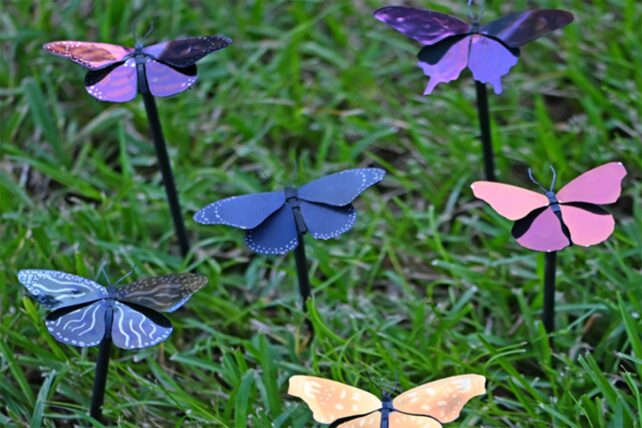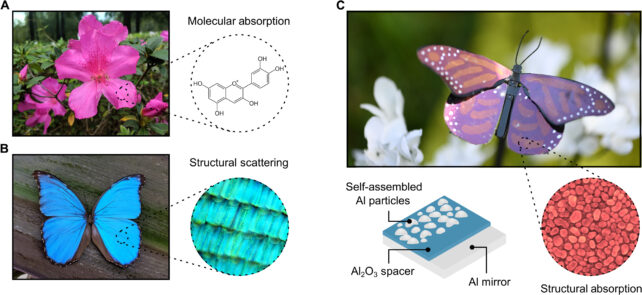Researchers have developed a new energy-saving paint that repels heat, comes in any color, and should last centuries. It's also the lightest paint created to date.
Inspired by butterfly wings, this paint isn't made from pigment. Instead, color is created structurally through the arrangement of nanoparticles. The team is calling it 'plasmonic paint'.
Based on their calculations, it would only take 1.4 kilograms (3 pounds) of plasmonic paint to cover a Boeing 747 – you'd need at least 454 kilograms (1,000 pounds) of conventional commercial paint to do the same.
That means it could significantly reduce the amount of greenhouse gases required for flight.
To be clear, this paint has only been created in the lab, so we're a long way away from producing it en masse.
But the researchers have already made the paint in various colors using techniques that can easily be scaled up, and that's what they'll be working on next.

One big motivator for taking this paint to market is that it can also help to keep structures cooler: Plasmonic paint's structure reflects the entire infrared spectrum, so less heat is absorbed.
The researchers say that surfaces underneath the new paint stay 13 to 16 degrees Celsius (25 to 30 degrees Fahrenheit) cooler than they would if they were covered with regular commercial paint.
"Over 10 percent of total electricity in the US goes toward air conditioner usage," says nanoscientist Debashis Chanda from the University of Central Florida, who led the team that created the paint.
"The temperature difference plasmonic paint promises would lead to significant energy savings. Using less electricity for cooling would also cut down carbon dioxide emissions, lessening global warming."
Currently, pigment-based paints require specific molecules to build color, and usually, in modern paints, those pigments are artificially synthesized.
The electronic properties of each molecule control how much light is absorbed and, therefore, which color the paint appears. That means there needs to be a new pigment for every new paint color.
Instead, plasmonic paint uses the nanoparticles of two colorless materials – aluminum and aluminum oxide. By arranging them in different ways on top of an oxide-coated aluminum mirror, it's possible to control how light is scattered, reflected, or absorbed.
A similar process is responsible for the rich color of butterfly wings.
"The range of colors and hues in the natural world [is] astonishing – from colorful flowers, birds, and butterflies to underwater creatures like fish and cephalopods," says Chanda.
"Structural color serves as the primary color-generating mechanism in several extremely vivid species where geometrical arrangement of typically two colorless materials produces all colors. On the other hand, with [human-made] pigment, new molecules are needed for every color present."

The structural color is what makes the paint so lightweight – at a thickness of just 150 nanometers, the paint reaches full coloration, making it the lightest paint on record.
In this research, the team created the structural paint using an electron beam evaporator which heats a substance at a highly controlled rate.
This controlled evaporation allows small clusters of aluminum nanoparticles to self-assemble – the aluminum atoms are more attracted to each other than the oxide substrate they're grown on, so they naturally clump up.
By tweaking the pressure and temperature of the electron beam evaporator, the team can create structures that reflect different colors.
"Crucially, this pressure- and temperature-controlled process ensures high reproducibility over broad areas in a single step, lowering the cost of production and enabling large-scale fabrication," the team writes in their paper.
The researchers also combined their structural color flakes with a commercial binder, which means the paint will last for hundreds of years – at least, in theory.
"Normal color fades because pigment loses its ability to absorb photons," says Chanda.
"Here, we're not limited by that phenomenon. Once we paint something with structural color, it should stay for centuries."
This isn't the first new kind of paint to promise some incredible properties. Many of you will have heard of Vantablack – one of the blackest paints in the world, capable of absorbing 99.96 percent of light.
Similar to plasmonic paint, this super blackness is the result of tiny carbon nanotubes, and even blacker paints have been created based on the same method since.
There's also ultra-white paint, which reflects 98.1 percent of all light and promises to significantly reduce air conditioning needs. But unlike plasmonic paint, the ultra-white paint relies on pigments to reflect light, and Vantablack currently only comes in one color.
Still, there's a long way to go before we're all customizing our own plasmonic paint colors and using just one tiny can to paint an entire house.
"The conventional pigment paint is made in big facilities where they can make hundreds of gallons of paint," says Chanda.
"At this moment, unless we go through the scale-up process, it is still expensive to produce at an academic lab."
The research has been published in Science Advances.
